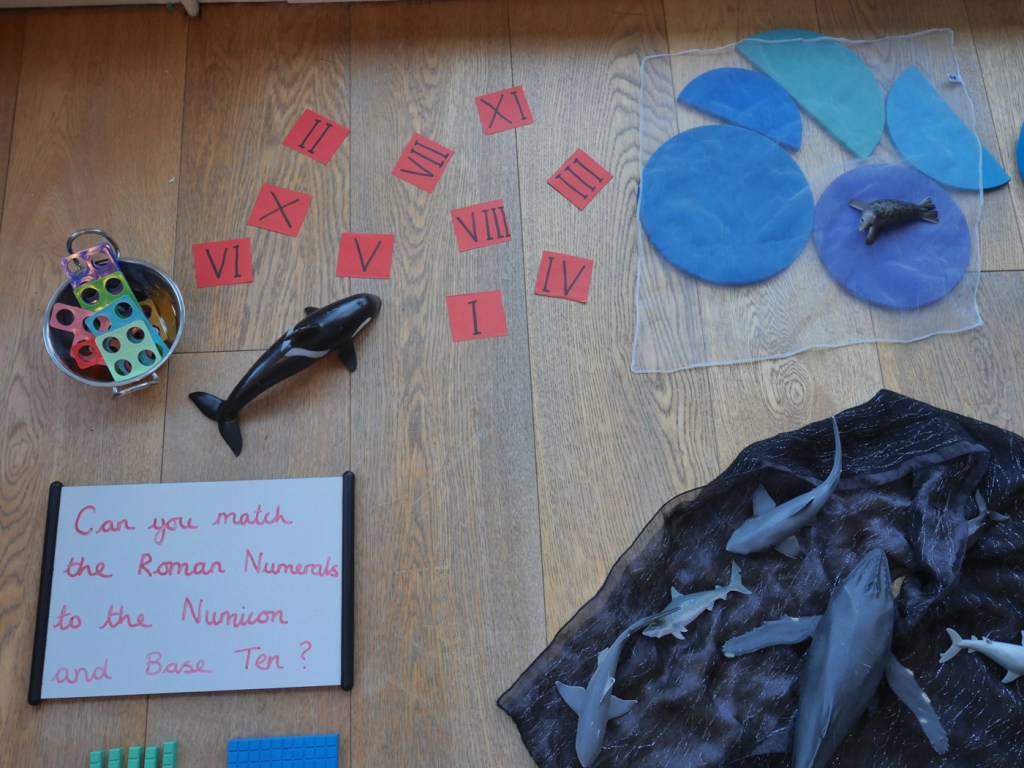Ioan and Finny chose to do some Roman numeral work on Frozen Planet II and Blue Planet II. They thought it was appropriate seeing as there are Roman numerals in the documentary titles.
Resources
- Sea creature figures
- Roman numerals 1-10 and multiples of ten up to 100
- Numicon
- Base Ten set
- Place Value Disks
- Whiteboards and pens
- Circus scarves
Finny filmed the opening scenes of Frozen Planet:









He showed me the magnatile ship he’d made for David Attenborough to sail round while filming Frozen Planet II.
What are Roman numerals?
Roman numerals are the symbols used in a system of numerical notation based on the ancient Roman system. The symbols are I, V, X, L, C, D, and M, standing respectively for 1, 5, 10, 50, 100, 500, and 1,000.
A maximum of ____ of the same symbol can be used in a number.
Finny explained that David Attenborough had lost one of the numbers from his script. It explained one of the important rules for using Roman numerals.
Roman numerals can’t be joined together more than 3 times. For example, we can’t write 40 as XXXX.









Can you match the Roman Numerals to the Numicon and Base Ten?






Finny and Ioan worked together to order the Roman numerals, explaining their working out as they went.
Once they had ordered the numerals, they matched the Base Ten and Numicon to them.
Finny then showed us one of his favourite scenes from Frozen Planet II. He explained how a killer whale could hunt a seal by cracking up the ice, then pushing the smaller iceberg into clear water, and finally diving under the ice and tipping the seal in to the water.









Ioan then filmed his opening credits to Blue Planet II.






When a symbol is written _____ a larger or equal symbol it it ______.









Ioan went first to fill in the blanks with two words that made sense.
When a Roman numeral is placed after another Roman Numeral of greater value, the numerals are added.
He used Numicon to demonstrate that 6 = 5 + 1.
In Roman numerals VI = V + I. Because the I (one) is written after the V (five) it is added.






Finny had a go at finding an alternative sentence that made sense.
When a Roman numeral is placed before another Roman numeral of greater value, the smaller numeral is subtracted.
He used Numicon to demonstrate that 5 – 1 = 4.
In Roman numerals IV = V – I. Because the I (one) is written before the V (five) it is subtracted.









Ioan then acted out the scene from Blue Planet II. The penguins had to get past the hunting seal and fighting elephant seal, to return to their colony of hungry chicks.






Help the humpback whale escape from the sharks. Make XXVII, LXVIII, XIX and XCI.
Ioan suggested they split the Roman numerals in half and each do two examples. Finny took the left two examples an Ioan the right two.
Their first step was to split their Roman numerals in to numbers they recognised. Then, they used the number line of Roman numerals they made with the Numicon and Base Ten to help them work out the number it represented.















The sharks were trying to attack the humpback whale, but the humpback used it’s size to keep them at bay.
David Attenborough was then able to complete his mission and return the baby sea turtle to it’s mother.









One (of the many) things I love about child led learning, is that I have no idea what theme they will tie in with their maths work. It is lovely to see the cross curricular links they bring in naturally. Unsurprisingly this work on Roman numerals led on to a lot of science exploration.









I left them to play and came back to see the Roman numerals set out like this, with base ten and place value counters to complete the number line counting in multiples of 10.



DfES National Curriculum (2013)
Numeracy Year 4 programme of study
Number – number and place value
- read Roman numerals to 100 (I to C) and know that over time, the numeral system changed to include the concept of zero and place value.
Roman numerals should be put in their historical context so pupils understand that there have been different ways to write whole numbers and that the important concepts of zero and place value were introduced over a period of time.












